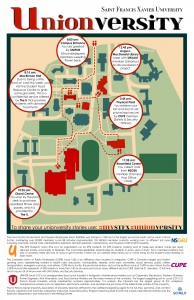This article, written by StFXAUT Communications Officer Philip Girvan, appeared in the Winter 2018 edition of The Beacon.
Over the next several issues The Beacon will highlight work performed and challenges faced by the non-academic Unions working at StFX University. This article profiles CUPE Local 1636. CUPE Local 1636 represents StFX Safety and Security Services employees (currently 12 full-time employees and 4 casuals). Last Fall The Beacon met with former CUPE Local 1636 President John Gormley and former Vice-President Dane Hiltz. Both Gormley and Hiltz were quick to emphasize that their “biggest issue is, and always has been, just the amount of time it takes to get things settled”.
For some time they have been trying to engage university Administration concerning risk assessment. “We asked the University what they consider our role to be for the University and they don’t know. They can’t give us a defined explanation of what specifically our exact role is here,” said Hiltz. This indecisiveness surrounding what Gormley termed as “procedures for our responses for certain situations” impacts the safety of Safety and Security Services personnel.
Gormley and Hiltz emphasized that: “We want to do it together. We’re discussing it. We don’t want to be more or less told what we require. We want the risk assessment to determine what it is. So we don’t want to push for something we don’t need, but also we don’t want to not have what we need”.
When asked to clarify, Hiltz mentioned: “safety equipment, personal protective equipment (PPE) — things that we might not currently have that we want but it’s all procedural-based”. Risk assessment would be based on “past incidents, on past interactions with students, staff, and faculty, the public”.

Interactions with students have always been part of the job, but the nature of these has changed. Gormley noted that, “this has been a fairly good year”. Hiltz added that “it’s better than it used to be” and attributed the change to Student Life. Gormley agreed, crediting Student Life with being “more proactive”. Hiltz recalled that there “used to [be] incidents all the time. Recently, within the past couple of years, our involvement with the interior of residences has been non-existent. We don’t go into the residences unless requested by residence staff”.
As has been heard from other Unions on campus, things have improved following the change in Administration. Gormley noted that “just communicating is a success. It wasn’t as open. The doors were a little shut”.
Hiltz agreed: “It wasn’t until probably the last year or so that we even had quarterly meetings. We had biannual meetings [scheduled] with the [previous] Administration. That wasn’t happening at all. So that changed. Just 15 minute, 30 minute catch ups”.
The job’s biggest change is Safety and Security Services’ increased capacity to document incidents and interactions. Hiltz noted that, when he started six years ago, “we didn’t have a main service desk location. There was no person in here [gestures to the office surroundings] answering the phone, making cards and keys, that didn’t exist. My first shift I had a chair to sit on, a phone, and a computer that didn’t have anything on it. They said, ‘if the phone rings, answer it’. It didn’t ring”.
Hiltz continued: “Access control wasn’t really part of the whole deal. Residence office controlled keys for students if they were having any sort of key issue. ID cards were issued by residence office. All that we handle now”.
“Like night and day,” Gormley described the transformation in record keeping and documentation. He credited current manager Robert Proctor for implementing new systems. Safety and Security Services is now the first point of contact for anyone working, living, visiting, or otherwise engaged on campus. According to Gormley, “it’s gone from the phone not ringing to us responding to twenty thousand service requests a year”.
